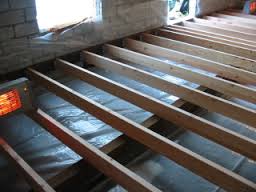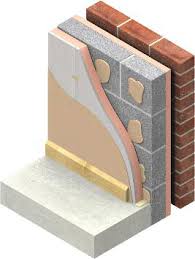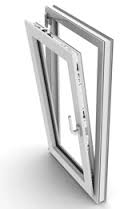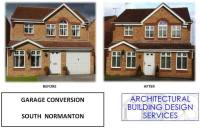Garage Conversions - Part Two← Back
Posted 7 Years, 11 Months, 2 Weeks, 14 Hours, 6 Minutes ago.
Following our first part in this series of blogs about converting your disued (or misused) garage space, here we look at some of the practicalities that you may need to consider.
Raising the Floor Level
 As part of a conversion, a garage floor will need to be raised due to them being designed to be lower than the floor in the main house and often with a slope down towards the garage door. Whichever way that you choose to raise the levels, it is paramount to consider the insulation and damp proofing. There are two main options to choose from:
As part of a conversion, a garage floor will need to be raised due to them being designed to be lower than the floor in the main house and often with a slope down towards the garage door. Whichever way that you choose to raise the levels, it is paramount to consider the insulation and damp proofing. There are two main options to choose from:
Option 1 : Concrete
A polythene membrane is placed over the garage floor, floor insulation is laid down, a second polythene membrane is installed and the floor level is raised to same level as your main house by using concrete or sand and cement screed.
Option 2 : Timber
Treated timber floor joists are placed onto a damp-proof membrane over the top of the existing concrete floor joists, with floor boards or tongued and grooved chipboard.
You can then finish the floor with carpet, laminate or your choice of covering.
Lining the External Walls
When converting a garage, the walls will need to be upgraded as they are usually only formed of a single thickness of brickwork.
There are three areas to consider when carrying this out which are the conversion, weather and damp resistance and insulation and sound resistance.
The upgrading scheme will be ruled by the original construction but generally these are ruled into two categories:
Cavity Walls : With this type of installation, weather resistance and damp-proofing are unlikely to be an issue. As long as the wall is in good condition, with no signs of water ingress or rising damp, they will generally only require insulation and a plaster finish ready for decorating. You can choose from cavity wall insulation or an insulated lining board. We can offer you guidance on this where necessary.
Solid Brick Walls : As garages will often be constructed from a single brick wall, approx 100mm thick, it will not provide adequate weather resistance to a habitable room so a supplementary wall must be constructed behind the original wall. This can be done by building an additional skin of masonary to form a cavity wall, which can be insulated as the wall is built. The wall can then be dry-lined or plastered. The other option is to construct an independent timber-framed wall, constructed from treated timber with insulation provided between the timber stubs, with a cavity between the new framing and existing wall.
Sometimes a garage may be constructed of 22mm thick solid brick walls, which in good condition with a damp-proof course can normally provide adequate weather resistance, however, they will still need lining with an insulating board to increase insulation.
Party Walls
If any of the walls in your garage are connected to a neighbouring property, then these are classed as Party Walls. These walls will need upgrading to reduce sound transfer between your new room and the neighbouring property but we will be happy to advice you on the best way forward with this.
(You can find out more about Party Wall's in our blog series, you will find Part One here with links to the consequetive ones)
 The Ceiling
The Ceiling
An adequate ceiling will need to be provided for your conversion. The most common material for this is plasterboard as it offers good fire-resistance and flame-spread properties. If the garage is open to a roof then you will need to provide insulation above the ceiling and roof-void and ventilation above the insulation. There are other contraints to bear in mind with the ceilings of a garage conversion but we will be happy to advice you of your best route.
Heating
Maximising the usage of a conversion will need the installation of heating. In the majority of cases, the most effective way of achieving this is to extend the current central heating system but always check with a registered plumber or heating engineer. Other heating systems such as electric panel heaters are also available but always place careful consideration on efficient ways to run them.
Drainage
Consider drainage at an early stage if your aim is to include a sink, bathroom or shower room in your conversion. Any new appliances must be connected to your existing foul drainage system as they are not allowed to be connected into rainwater drains. Ensure that their are suitable routes for pipes to run when planning your layouts.
Windows and Ventilation
Habitable rooms must be ventilated, usually by means of an opening window equivalent to 1/20th of the floor area to the room, with a trickle vent at high level. New windows must be highly-efficient double glazed units and it is recommended that they contain an opener with a clear area of at least 0.33m and 450mm wide. (Large enough to escape in the event of a fire). This is essential if the door out of your garage opens into a room other than your entrance hall. If you plan to have a bath/shower room in your conversion then it is important to have extract fans fitted if the room has no opening windows.
Fire Precautions
Review your fire precautions when spending money on alterations to your home. Mains-operated smoke detection significantly improves fire-safety in the home and it is a requirement from Building Regulations when garages are converted into habitable rooms.
Electrics
Depending on the age of your electrical installation, you may be able to have extensions off existing circuits to feed your conversion, and some may already be in place if your garage has lighting and electric sockets. In some instances though, complete new circuits are required and maybe even a new distribution board. Always appoint a qualified electrician to carry out this type of work so they can issue correct certification. If you need help in choosing a contractor, then please speak to us as we work alongside contractors that we can happily connect you to.
 CONCLUSION
CONCLUSION
A coverted garage can be a definite asset to your home, if carried out correctly. It will provide useful extra living space and add value to your property. Plan the work carefully and have it carried out by professionals so that you don't compromise the safety and structural integrity of your home.
Architectural Building Design Services have plenty of experience with working on conversions so please do not delay to contact us for help. You will find all of our contact details here.
Raising the Floor Level
 As part of a conversion, a garage floor will need to be raised due to them being designed to be lower than the floor in the main house and often with a slope down towards the garage door. Whichever way that you choose to raise the levels, it is paramount to consider the insulation and damp proofing. There are two main options to choose from:
As part of a conversion, a garage floor will need to be raised due to them being designed to be lower than the floor in the main house and often with a slope down towards the garage door. Whichever way that you choose to raise the levels, it is paramount to consider the insulation and damp proofing. There are two main options to choose from:Option 1 : Concrete
A polythene membrane is placed over the garage floor, floor insulation is laid down, a second polythene membrane is installed and the floor level is raised to same level as your main house by using concrete or sand and cement screed.
Option 2 : Timber
Treated timber floor joists are placed onto a damp-proof membrane over the top of the existing concrete floor joists, with floor boards or tongued and grooved chipboard.
You can then finish the floor with carpet, laminate or your choice of covering.
Lining the External Walls
When converting a garage, the walls will need to be upgraded as they are usually only formed of a single thickness of brickwork.
There are three areas to consider when carrying this out which are the conversion, weather and damp resistance and insulation and sound resistance.

The upgrading scheme will be ruled by the original construction but generally these are ruled into two categories:
Cavity Walls : With this type of installation, weather resistance and damp-proofing are unlikely to be an issue. As long as the wall is in good condition, with no signs of water ingress or rising damp, they will generally only require insulation and a plaster finish ready for decorating. You can choose from cavity wall insulation or an insulated lining board. We can offer you guidance on this where necessary.
Solid Brick Walls : As garages will often be constructed from a single brick wall, approx 100mm thick, it will not provide adequate weather resistance to a habitable room so a supplementary wall must be constructed behind the original wall. This can be done by building an additional skin of masonary to form a cavity wall, which can be insulated as the wall is built. The wall can then be dry-lined or plastered. The other option is to construct an independent timber-framed wall, constructed from treated timber with insulation provided between the timber stubs, with a cavity between the new framing and existing wall.
Sometimes a garage may be constructed of 22mm thick solid brick walls, which in good condition with a damp-proof course can normally provide adequate weather resistance, however, they will still need lining with an insulating board to increase insulation.
Party Walls
If any of the walls in your garage are connected to a neighbouring property, then these are classed as Party Walls. These walls will need upgrading to reduce sound transfer between your new room and the neighbouring property but we will be happy to advice you on the best way forward with this.
(You can find out more about Party Wall's in our blog series, you will find Part One here with links to the consequetive ones)
 The Ceiling
The CeilingAn adequate ceiling will need to be provided for your conversion. The most common material for this is plasterboard as it offers good fire-resistance and flame-spread properties. If the garage is open to a roof then you will need to provide insulation above the ceiling and roof-void and ventilation above the insulation. There are other contraints to bear in mind with the ceilings of a garage conversion but we will be happy to advice you of your best route.
Heating
Maximising the usage of a conversion will need the installation of heating. In the majority of cases, the most effective way of achieving this is to extend the current central heating system but always check with a registered plumber or heating engineer. Other heating systems such as electric panel heaters are also available but always place careful consideration on efficient ways to run them.
Drainage
Consider drainage at an early stage if your aim is to include a sink, bathroom or shower room in your conversion. Any new appliances must be connected to your existing foul drainage system as they are not allowed to be connected into rainwater drains. Ensure that their are suitable routes for pipes to run when planning your layouts.
Windows and Ventilation

Habitable rooms must be ventilated, usually by means of an opening window equivalent to 1/20th of the floor area to the room, with a trickle vent at high level. New windows must be highly-efficient double glazed units and it is recommended that they contain an opener with a clear area of at least 0.33m and 450mm wide. (Large enough to escape in the event of a fire). This is essential if the door out of your garage opens into a room other than your entrance hall. If you plan to have a bath/shower room in your conversion then it is important to have extract fans fitted if the room has no opening windows.
Fire Precautions
Review your fire precautions when spending money on alterations to your home. Mains-operated smoke detection significantly improves fire-safety in the home and it is a requirement from Building Regulations when garages are converted into habitable rooms.
Electrics
Depending on the age of your electrical installation, you may be able to have extensions off existing circuits to feed your conversion, and some may already be in place if your garage has lighting and electric sockets. In some instances though, complete new circuits are required and maybe even a new distribution board. Always appoint a qualified electrician to carry out this type of work so they can issue correct certification. If you need help in choosing a contractor, then please speak to us as we work alongside contractors that we can happily connect you to.
 CONCLUSION
CONCLUSIONA coverted garage can be a definite asset to your home, if carried out correctly. It will provide useful extra living space and add value to your property. Plan the work carefully and have it carried out by professionals so that you don't compromise the safety and structural integrity of your home.
Architectural Building Design Services have plenty of experience with working on conversions so please do not delay to contact us for help. You will find all of our contact details here.
